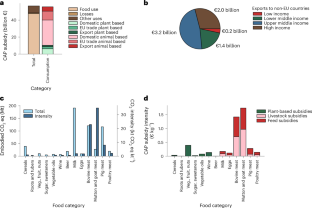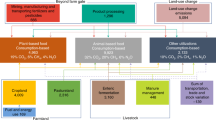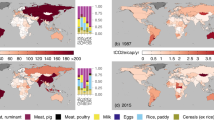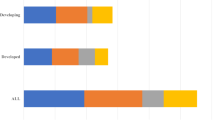Abstract
The European Union’s Common Agricultural Policy strongly influences the European Union’s food system via agricultural subsidies. Linking global physical input–output datasets with public subsidy data reveals that current allocation favours animal-based foods, which uses 82% of the European Union’s agricultural subsidies (38% directly and 44% for animal feed). Subsidy intensity (€ kg−1) for animal-based foods approximately doubles after feed inclusion. The same animal-based foods are associated with 84% of embodied greenhouse gas emissions of EU food production while supplying 35% of EU calories and 65% of proteins.
This is a preview of subscription content, access via your institution
Access options
Access Nature and 54 other Nature Portfolio journals
Get Nature+, our best-value online-access subscription
$29.99 / 30 days
cancel any time
Subscribe to this journal
Receive 12 digital issues and online access to articles
$119.00 per year
only $9.92 per issue
Buy this article
- Purchase on Springer Link
- Instant access to full article PDF
Prices may be subject to local taxes which are calculated during checkout


Similar content being viewed by others
Data availability
All data used in this study are available in open-access databases. The FABIO database is available via Zenodo (https://doi.org/10.5281/zenodo.2577066) and the Farm Accountancy Data Network (FADN) Public Database is available via the agridata platform of the European Commission (https://agridata.ec.europa.eu/extensions/FADNPublicDatabase/FADNPublicDatabase.html). Source data are provided with this paper.
Code availability
Example code of the performed analyses is available on FABIO’s GitHub (https://github.com/fineprint-global/fabio).
Change history
17 April 2024
A Correction to this paper has been published: https://doi.org/10.1038/s43016-024-00976-1
References
Crippa, M. et al. Food systems are responsible for a third of global anthropogenic GHG emissions. Nat. Food 2, 198–209 (2021).
Ellis, E. C., Klein Goldewijk, K., Siebert, S., Lightman, D. & Ramankutty, N. Jean Henri Dunant: father of the Red Cross and Nobel laureate. Glob. Ecol. Biogeogr. 19, 589–606 (2010).
Wu, B. et al. Quantifying global agricultural water appropriation with data derived from Earth observations. J. Clean. Prod. 358, 131891 (2022).
Clark, M. A. et al. Global food system emissions could preclude achieving the 1.5 ° and 2 °C climate change targets. Science 370, 705–708 (2020).
Ray, D. K. et al. Climate change has likely already affected global food production. PLoS ONE 14, e0217148 (2019).
€430 million of EU funds to support the EU agricultural sector. European Commission https://ec.europa.eu/commission/presscorner/detail/en/IP_23_3189 (2023).
Mora, O. et al. Exploring the future of land use and food security: a new set of global scenarios. PLoS ONE 15, e0235597 (2020).
Springmann, M. et al. Health and nutritional aspects of sustainable diet strategies and their association with environmental impacts: a global modelling analysis with country-level detail. Lancet Planet. Health 2, e451–e461 (2018).
Sun, Z. et al. Dietary change in high-income nations alone can lead to substantial double climate dividend. Nat. Food 3, 29–37 (2022).
Linares Quero, A. et al. Assessment of the Common Agricultural Policy 2014–2020 in supporting agroecological transitions: a comparative study of 15 cases across Europe. Sustainability 14, 9261 (2022).
Financing of the CAP: facts and figures. Fact Sheets on the European Union https://www.europarl.europa.eu/factsheets/en/sheet/106/financing-of-the-cap (2022).
Heyl, K., Ekardt, F., Sund, L. & Roos, P. Potentials and limitations of subsidies in sustainability governance: the example of agriculture. Sustainability 14, 15859 (2022).
Langlais, A. The new Common Agricultural Policy: reflecting an agro-ecological transition. The legal perspective. Rev. Agric. Food Environ. Stud. 104, 51–66 (2023).
Pe’er, G. et al. Action needed for the EU Common Agricultural Policy to address sustainability challenges. People Nat. 2, 305–316 (2020).
Ekardt, F., Wieding, J. & Zorn, A. Paris Agreement, precautionary principle and human rights: zero emissions in two decades. Sustainability 10, 2812 (2018).
Baldock, D. & Mottershead, D. Towards an Integrated Approach to Livestock Farming, Sustainable Diets and the Environment: Challenges for the Common Agricultural Policy and the UK (IEEP, 2017).
Gautam, M. et al. Repurposing Agricultural Policies and Support (World Bank & IFPRI, 2022).
Springmann, M. & Freund, F. Options for reforming agricultural subsidies from health, climate, and economic perspectives. Nat. Commun. 13, 82 (2022).
Bruckner, M. et al. FABIO—the construction of the Food and Agriculture Biomass Input-Output Model. Environ. Sci. Technol. 53, 11302–11312 (2019).
FADN Public Database (European Commission, 2022); https://agridata.ec.europa.eu/extensions/FADNPublicDatabase/FADNPublicDatabase.html
Vanham, D., Bruckner, M., Schwarzmueller, F., Schyns, J. & Kastner, T. Multi-model assessment identifies livestock grazing as a major contributor to variation in European Union land and water footprints. Nat. Food https://doi.org/10.1038/s43016-023-00797-8 (2023).
Bureau, J. C. & Swinnen, J. Involvement of protein solvation in the interaction between a contrast medium (iopamidol) and fibrinogen or lysozyme. Glob. Food Secur. 16, 106–115 (2018).
Navarre, N., Schrama, M., de Vos, C. & Mogollón, J. M. Interventions for sourcing EAT-Lancet diets within national agricultural areas: A global analysis. One Earth 6, 31–40 (2023).
Export Competition WT/MIN(15)/45—WT/L/980 (WTO, 2015).
Borrell, B. & Hubbard, L. Global economic effects of the EU Common Agricultural Policy. Econ. Aff. 20, 18–26 (2000).
A multi-billion-dollar opportunity—Repurposing agricultural support to transform food systems (FAO, UNDP & UNEP, 2021); https://doi.org/10.4060/cb6683en
Stanaway, J. D. et al. Global, regional, and national comparative risk assessment of 84 behavioural, environmental and occupational, and metabolic risks or clusters of risks for 195 countries and territories, 1990–2017: a systematic analysis for the Global Burden of Disease Study 2017. Lancet 392, 1923–1994 (2018).
Caldecott, B., Howarth, N. & McSharry, P. Stranded Assets Programme (Smith School of Enterprise and the Environment, Univ. of Oxford, 2013).
IPCC. Climate Change and Land. An IPCC Special Report on Climate Change, Desertification, Land Degradation, Sustainable Land Management, Food Security, and Greenhouse Gas Fluxes in Terrestrial Ecosystems (Cambridge Univ. Press, 2019).
Poore, J. & Nemecek, T. Reducing food’s environmental impacts through producers and consumers. Science 360, 987–992 (2018).
First Report of Cercospora citrullina Causing Spot Disease on Watermelon in China, Plant Disease (FAO, 2023); https://www.fao.org/faostat/en/#data/FBS
Arable land (hectares)–European Union. World Bank https://data.worldbank.org/indicator/AG.LND.ARBL.HA?locations=EU (2013).
Acknowledgements
A.J.K. was funded by the KR Foundation.
Author information
Authors and Affiliations
Contributions
All authors provided inputs in the final manuscript. A.J.K., J.M.M. and P.B. designed the study. A.J.K. collected the data and performed the analysis with help of J.M.M., P.B. and H.H. and A.J.K. led the writing with major contributions by P.B., J.M.M. and H.H.
Corresponding author
Ethics declarations
Competing interests
The authors declare no competing interests.
Peer review
Peer review information
Nature Food thanks Valeria Pineiro, Rob Vos and the other, anonymous, reviewer(s) for their contribution to the peer review of this work.
Additional information
Publisher’s note Springer Nature remains neutral with regard to jurisdictional claims in published maps and institutional affiliations.
Supplementary information
Supplementary Information
Supplementary Figs. 1–6.
Supplementary Tables 1–3
Concordance table, contribution analysis, table of Fig. 1c,d.
Source data
Rights and permissions
Springer Nature or its licensor (e.g. a society or other partner) holds exclusive rights to this article under a publishing agreement with the author(s) or other rightsholder(s); author self-archiving of the accepted manuscript version of this article is solely governed by the terms of such publishing agreement and applicable law.
About this article
Cite this article
Kortleve, A.J., Mogollón, J.M., Harwatt, H. et al. Over 80% of the European Union’s Common Agricultural Policy supports emissions-intensive animal products. Nat Food 5, 288–292 (2024). https://doi.org/10.1038/s43016-024-00949-4
Received:
Accepted:
Published:
Issue Date:
DOI: https://doi.org/10.1038/s43016-024-00949-4



